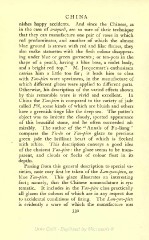Page 406 - Oriental Series Japan and China, Brinkly
P. 406
CHINA
nishes happy accidents. And since the Chinese, as
in the case of craquele, are so sure of their technique
that they can manufacture one pair of vases in which
red predominates, and another of which the almost
blue ground is strewn with red and lilac flames, they
also make statuettes with the flesh colour disappear-
ing under blue or green garments ; or tea-pots in the
shape of a peach, having a blue base, a violet body,
and a bright red top." M. Jacquemart's enthusiasm
carries him a little too far it leads him to class
;
with Tao-pien ware specimens, in the manufacture of
which different glazes were applied to different parts.
Otherwise, his description of the varied effects shown
by this remarable ware is vivid and excellent. In
China the Tao-pien is compared to the variety of jade
called Pih, some kinds of which are bluish and others
have a greenish tinge like the deep sea. The potter's
object was to imitate the cloudy, spotted appearance
of this beautiful stone, and he often succeeded ad-
"
mirably. The author of the " Annals of Fu-liang
compares the Tu-lu or Tao-pien glaze to precious
green jade the brilliant heart of which is flecked
with white. This description conveys a good idea
of the choicest Tao-pien : the glaze seems to be trans-
parent, and clouds or flecks of colour float in its
depths.
Passing from this general description to special va-
rieties, note may first be taken of the Lan-yao-pien, or
blue Tao-pien. This glaze illustrates an interesting
fact namely, that the Chinese nomenclature is sys-
;
tematic. It includes in the Tao-pien class practically
all glazes the colours of which are in any respect due
to accidental conditions of firing. The Lan-yao-pien
is evidently a ware of which the manufacture was

